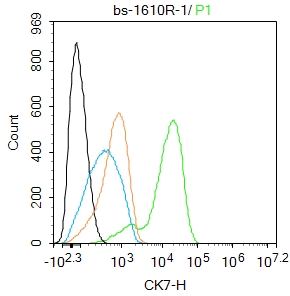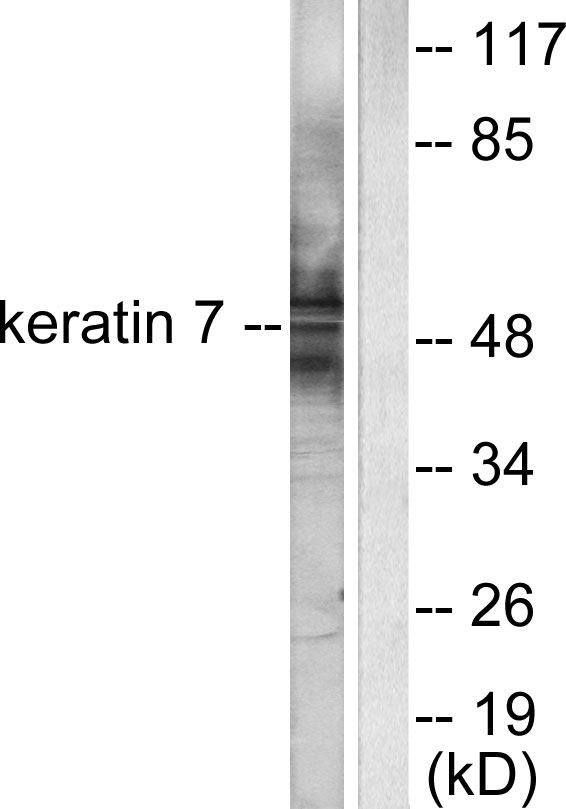Cytokeratin 7 antibody [N1C2]
GTX109723
ApplicationsImmunoFluorescence, Western Blot, ImmunoCytoChemistry, ImmunoHistoChemistry, ImmunoHistoChemistry Frozen, ImmunoHistoChemistry Paraffin
Product group Antibodies
ReactivityHuman
TargetKRT7
Overview
- SupplierGeneTex
- Product NameCytokeratin 7 antibody [N1C2]
- Delivery Days Customer9
- Application Supplier NoteWB: 1:5000-1:20000. ICC/IF: 1:100-1:1000. IHC-P: 1:100-1:1000. IHC-Fr: 1:100-1:1000. *Optimal dilutions/concentrations should be determined by the researcher.Not tested in other applications.
- ApplicationsImmunoFluorescence, Western Blot, ImmunoCytoChemistry, ImmunoHistoChemistry, ImmunoHistoChemistry Frozen, ImmunoHistoChemistry Paraffin
- CertificationResearch Use Only
- ClonalityPolyclonal
- Concentration0.76 mg/ml
- ConjugateUnconjugated
- Gene ID3855
- Target nameKRT7
- Target descriptionkeratin 7
- Target synonymsCK7, K2C7, K7, SCL, keratin, type II cytoskeletal 7, CK-7, cytokeratin 7, keratin 7, type II, keratin, 55K type II cytoskeletal, keratin, simple epithelial type I, K7, sarcolectin, type II mesothelial keratin K7, type-II keratin Kb7
- HostRabbit
- IsotypeIgG
- Protein IDP08729
- Protein NameKeratin, type II cytoskeletal 7
- Scientific DescriptionThe protein encoded by this gene is a member of the keratin gene family. The type II cytokeratins consist of basic or neutral proteins which are arranged in pairs of heterotypic keratin chains coexpressed during differentiation of simple and stratified epithelial tissues. This type II cytokeratin is specifically expressed in the simple epithelia lining the cavities of the internal organs and in the gland ducts and blood vessels. The genes encoding the type II cytokeratins are clustered in a region of chromosome 12q12-q13. Alternative splicing may result in several transcript variants; however, not all variants have been fully described. [provided by RefSeq]
- ReactivityHuman
- Storage Instruction-20°C or -80°C,2°C to 8°C
- UNSPSC12352203
References
- Wuputra K, Hsiao PJ, Chang WT, et al. FOXM1-CD44 Signaling Is Critical for the Acquisition of Regorafenib Resistance in Human Liver Cancer Cells. Int J Mol Sci. 2022,23(14). doi: 10.3390/ijms23147782Read this paper
- Wang YY, Chen HD, Lo S, et al. Visfatin Enhances Breast Cancer Progression through CXCL1 Induction in Tumor-Associated Macrophages. Cancers (Basel). 2020,12(12). doi: 10.3390/cancers12123526Read this paper
- Chen LC, Wang E, Tai CS, et al. Improving the reproducibility, accuracy, and stability of an electrochemical biosensor platform for point-of-care use. Biosens Bioelectron. 2020,155:112111. doi: 10.1016/j.bios.2020.112111Read this paper
- DaSilva-Arnold SC, Kuo CY, Davra V, et al. ZEB2, a master regulator of the epithelial-mesenchymal transition, mediates trophoblast differentiation. Mol Hum Reprod. 2019,25(2):61-75. doi: 10.1093/molehr/gay053Read this paper
- DaSilva-Arnold SC, Zamudio S, Al-Khan A, et al. Human trophoblast epithelial-mesenchymal transition in abnormally invasive placenta. Biol Reprod. 2018,99(2):409-421. doi: 10.1093/biolre/ioy042Read this paper
- Pei YF, Yin XM, Liu XQ. TOP2A induces malignant character of pancreatic cancer through activating β-catenin signaling pathway. Biochim Biophys Acta Mol Basis Dis. 2018,1864(1):197-207. doi: 10.1016/j.bbadis.2017.10.019Read this paper
- Hu J, Guan W, Liu P, et al. Endoglin Is Essential for the Maintenance of Self-Renewal and Chemoresistance in Renal Cancer Stem Cells. Stem Cell Reports. 2017,9(2):464-477. doi: 10.1016/j.stemcr.2017.07.009Read this paper







![IHC-P analysis of human tonsil tissue using GTX01662 Cytokeratin 7 + 8 antibody [CAM5.2] (ready-to-use) with GTX03612 Tissue Glue.](https://www.genetex.com/upload/website/prouct_img/normal/GTX01662/GTX01662_20220323_IHC-P_w_23053121_990.webp)